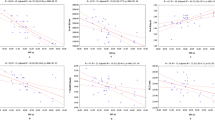Abstract
This study compared between performance indices of repeated sprint tests (RSTs) (12 × 20 m) during different stages of basketball game. Twelve young (17 ± 0.5 year) basketball players performed three RSTs (after a warm-up, at half-time and after a full game) and aerobic power test, each on different days. Ideal (fastest) sprint time (IS) was significantly faster at half-time (p < 0.007) compared to after warm-up. There was no difference between IS after the warm-up and after a full game. Total (accumulative) sprint time (TS) was significantly faster at half-time (p < 0.03) compared to after the warm-up. There was no difference between TS after the warm-up and after a full game. No differences were found in the performance decrement (PD) between the three RSTs. Significant negative correlations were found between predicted VO2 max and PD during the 12 × 20 m RST only when the RST was performed at half-time (r = −0.58) and after a full game (r = −0.59), and not when the RST was performed after the warm-up. The findings suggest that a more intense warm-up is needed for better repeated sprint performance at the initial phases of the game and that the aerobic system is important to intensity maintenance mainly during the last stages of the game.


Similar content being viewed by others
References
Balsom PD, Gaitanos GC, Ekblom B et al (1994) Reduced oxygen availability during high intensity intermittent exercise impairs performance. Acta Physiol Scand 152:279–285
Ben Abdelkrim N, El Fazaa S, El Ati J (2007) Time-motion analysis and physiological data of elite under-19-years-old basketball players during competition. Br J Sports Med 41:69–75
Bishop D (2003) Warm up II, performance changes following active warm up and how to structure the warm up. Sports Med 33:483–498
Bishop D, Spencer M, Duffield R et al (2001) The validity of a repeated sprint ability test. J Sci Med Sports 4:19–29
Bogdanis GC, Nevill ME, Boobis LH et al (1996) Contribution of phosphocreatine and aerobic metabolism to energy supply during repeated sprint exercise. J Appl Physiol 80:876–884
Borg GA (1982) Psychophysical bases of perceived exertion. Med Sci Sports Exer 14:377–382
Buteau P, Grosgeorge B, Handschuh R (1987) Basket-ball. Experimentation a l’INSEP, INSEP, Paris
Dawson BT, Fitzsimons M, Ward D (1993) The relationship of repeated sprint ability to aerobic power and performance measures of anaerobic work capacity and power. Aust J Sci Med Sport 25:88–92
Ekblom B (1986) Applied physiology of soccer. Sports Med 3:50–60
Fitzsimons M, Dawson BT, Ward D et al (1993) Cycling and running tests of repeated sprint ability. Aust J Sci Med Sport 25:82–87
Gaitanos GC, Williams C, Boobis LH et al (1993) Human muscle metabolism during intermittent maximal exercise. J Appl Physiol 75:712–719
Janeira MA, Maia J (1998) Game intensity in basketball. An interactionist view linking time-motion analysis, lactate concentration and heart rate. Coach Sport Sci J 3:26–30
MacLaren D (1990) Court games: volleyball and basketball. In: Reilly R, Secher N, Snell P et al (eds) Physiology of sports. E&FN Spon, London, pp 427–464
McGawley K, Bishop D (2006) Reliability of a 5 × 6-s maximal cycling repeated-sprint test in trained female team-sport athletes. Eur J Appl Physiol 98:382–393
McInnes SE, Carlson JS, Jones CJ et al (1995) The physiological load imposed on basketball players during competition. J Sports Sci 13:387–397
McMahon S, Wenger HA (1998) The relationship between aerobic fitness and both power output and subsequent recovery during maximal intermittent exercise. J Sci Med Sport 1:219–227
Meckel Y, Machnai O, Eliakim A (2009) Relationship among repeated sprint tests, aerobic fitness and anaerobic fitness in elite adolescent soccer players. J Strength Cond Res 23:163–169
Paliczka VJ, Nichols AK, Boreham CAG (1987) A multi-stage shuttle run as a predictor of running performance and maximal oxygen uptake in adults. Br J Sports Med 21:163–165
Ratel S, Williams CA, Oliver J et al (2006) Effects of age and recovery duration on performance during multiple treadmill sprints. Int J Sports Med 27:1–8
Slaughter MH, Lohman TG, Boileau RA et al (1988) Skinfold equation for estimation of body fatness in children and youth. Hum Biol 60:709–723
St Clair Gibson A, Broomhead S, Lambert MI et al (1998) Prediction of maximal oxygen uptake from a 20 m shuttle run as measured directly in runners and squash players. J Sports Sci 16:331–335
Stolen T, Chamari K, Castagna C et al (2005) Physiology of soccer. Sports Med 35:501–536
Tomlin DL, Wenger HA (2001) The relationship between aerobic fitness and recovery from high intensity intermittent exercise. Sports Med 31:1–11
Wadley G, Le RossIgnol P (1998) The relationship between repeated sprint ability and the aerobic and anaerobic energy systems. J Sci Med Sport 1:100–110
Author information
Authors and Affiliations
Corresponding author
Rights and permissions
About this article
Cite this article
Meckel, Y., Gottlieb, R. & Eliakim, A. Repeated sprint tests in young basketball players at different game stages. Eur J Appl Physiol 107, 273–279 (2009). https://doi.org/10.1007/s00421-009-1120-8
Accepted:
Published:
Issue Date:
DOI: https://doi.org/10.1007/s00421-009-1120-8




